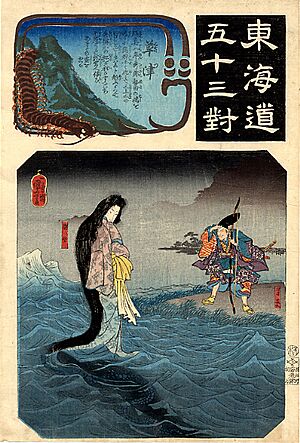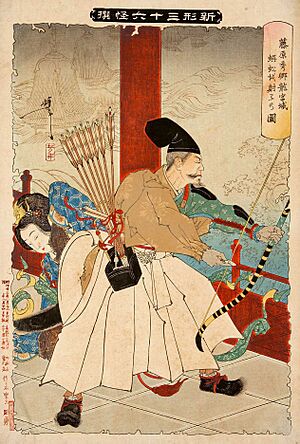Tawara Tōda Monogatari facts for kids
The story of The Tale of Tawara Tōda (俵藤太物語 ([Tawara Tōda monogatari] Error: {{nihongo}}: text has italic markup (help))) is a famous Japanese heroic tale. It tells about the amazing adventures of a hero named Fujiwara no Hidesato. This tale is part of a group of old Japanese stories called otogi-zōshi, which were popular around the Edo period (1603-1868) or even earlier. Some parts of this exciting story are also found in an old military history book called Taiheiki from the 14th century.
In the story, Hidesato uses his bow and arrow to defeat a huge centipede. This giant creature was wrapped around a mountain near Lake Biwa. He did this to help a serpent he met on a bridge. The serpent later turned into a beautiful lady from an underwater palace called the Dragon Palace (Ryūgū-jō (龍宮城)). As a reward, Hidesato was invited to the palace. There, he received special gifts like magical armor, a sword, and a bag of rice that never ran out.
The story is also known by its English titles. Basil Hall Chamberlain called it "My Lord Bag-O'-Rice" in his 1887 fairy tale book. Later, Yei Theodora Ozaki translated it as "My Lord Bag of Rice" in 1903. Her version was based on a retelling by Iwaya Sazanami.
Contents
Story Setting
The adventure begins in a place called Ōmi Province, which is now Shiga Prefecture in Japan. The story starts with a very large serpent lying across the Seta Bridge. This bridge is located at the edge of Lake Biwa.
The serpent, which later changes into a human, guides Hidesato to the Dragon Palace. This magical palace is hidden deep under the waters of Lake Biwa.
Near the Seta Bridge at Lake Biwa, there is a Shinto shrine. People there have honored Tawara Tōda for a long time.
Who is Tawara Tōda?
Tawara Tōda (俵藤太) is a nickname given to the real historical figure, Fujiwara no Hidesato. The name "Tawara Tōda" means "Rice-bag Tōda." It's a clever play on words using tawara, which means "straw rice-bag" or "straw barrel," and the family name or place name 田原 (Tawara).
Fujiwara no Hidesato was an important person in Japan during the early 900s. He was famous for helping to stop a rebellion led by a warrior named Taira no Masakado.
The Tale of Tawara Tōda
The legend of Hidesato defeating the giant centipede became very popular. It was widely read during the early Edo period (17th century). People copied the story into picture scrolls called emaki and printed it in books.
Here is a summary of the story from the Tawara Tōda monogatari:
Fujiwara no Hidesato came across a huge serpent on the Seta Bridge in Ōmi Province. This serpent was so big it was blocking travelers. Hidesato was not scared. He bravely stepped onto the serpent's back and walked right over it, continuing on his way.
That night, a young woman visited him. She told him she was the serpent he had seen earlier. She explained that a giant centipede had moved onto Mount Mikami, near Lake Biwa where she lived. This centipede was eating all the animals and fish, and even her own family members.
Hidesato agreed to help her get rid of the creature. He went back to Seta. When the centipede appeared, it looked like thousands of torches were coming down the mountain. Hidesato shot two arrows, but they didn't harm the centipede.
He then put some of his own saliva on his third arrow and prayed to his protector god, Hachiman. This time, the arrow hit the centipede, causing it great pain. Hidesato then went closer and cut the creature into many pieces.
The dragon woman was overjoyed. She gave Hidesato amazing magical gifts. These included bolts of silk that never ran out, a rice bag that always stayed full, and a special pan made of crimson copper that could create anything. Because of this magical rice bag (tawara), Hidesato earned his nickname, Tawara Tōda.
The dragon woman then took him to the Dragon Palace (Ryūgū (龍宮城)). There, he was treated like a king and given even more gifts from the Dragon King. Hidesato received a special armor, a sword, and a crimson copper bell. Later, Hidesato gave this bell to the Mii-dera temple, which is located at the base of Mount Hiei.
The monogatari version of the story likely grew from older accounts found in the 14th-century Taiheiki. Over time, more magical and religious details were added to the tale. The Tawara Tōda monogatari also includes a second part where Hidesato defeats Taira no Masakado. Masakado had a body of iron that could only be hurt at his temples, and he could create six ghostly copies of himself.
The Taiheiki Version
The 14th-century book Taiheiki has an earlier version of Hidesato's legend. In this version, the dragon does not turn into a beautiful woman. Instead, it changes into a "strange small man," who is the Dragon King himself.
In the Taiheiki version, Hidesato is first invited to the Dragon Palace. After that, he fights the centipede that is attacking the underwater kingdom. Here, the Dragon King gives him the silk that never runs out and the endless rice bag. However, he does not receive the copper pan, only the copper temple bell.
Fairy Tale Translations
An English version of the tale called "My Lord Bag-O'-Rice" was translated by Basil Hall Chamberlain in 1887. It was published as part of the Japanese Fairy Tale Series.
Another Japanese fairy tale version, ”Tawara Tōda" (「俵藤太」), was retold by Iwaya Sazanami in the 1890s. Later, "My Lord Bag of Rice" was included in Japanese Fairy Tales (1903) by Yei Theodora Ozaki. Ozaki's book was illustrated by Kakuzō Fujiyama.
The story "My Lord Bag of Rice" can also be found in A Book of Dragons (1965) by Ruth Manning-Sanders. This version was illustrated by Robin Jacques.
|



